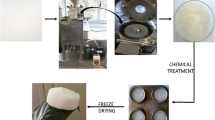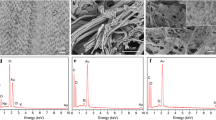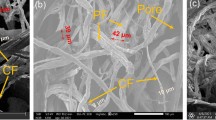Abstract
Spilled oil in seas has a direct impact on the environment and biodiversity. Moreover, there is no clear relationship between the amount of oil in the aquatic environment and its impact, since it mainly depends on the time and season that the oil is spilled. Nowadays, there are several techniques to clean up and recover oil from the sea, including the use of microorganisms, chemicals, controlled burning, dispersants and solidifiers, among others. Sometimes, unfortunately, the best option is to watch and wait for natural attenuation. Cellulose nanofibers have potential environmental applications due to their availability, light weight, mechanical and optical properties, and renewability. Several studies have dealt with modification of their hydrophilic character through silanation and acetylation. Both treatments, despite having a significant impact on the environment, are not plausible on a large scale because of the cost of chemicals and complexity of the modification. In this sense, the present work aims to develop hydrophobic nanocellulose-based aerogels from bleached kraft eucalyptus fibers modified with alkyl ketene dimers. For this, an experimental batch of 24 aerogels was prepared, including three types of CNF (TEMPO-oxidized, enzymatically hydrolyzed and mechanical) and eight modification degrees. The obtained aerogels were characterized in terms of morphology, hydrophilicity and water–oil absorption capacity under static and dynamic conditions, as well as their suitability for recycling and reuse for selective oil removal. The results showed that it is possible to obtain 3D-structured aerogels with a high oil absorption capacity by a simple and presumably low-cost methodology.







Similar content being viewed by others
References
Aulin C, Netrval J, Wågberg L, Lindström T (2010) Aerogels from nanofibrillated cellulose with tunable oleophobicity. Soft Matter 6:3298–3305
Ayadi F et al (2016) Mechanically flexible and optically transparent three-dimensional nanofibrous amorphous aerocellulose. Carbohydr Polym 149:217–223
Barry C (2007) Slick death: oil-spill treatment kills coral. Sci News 172:67
Cervin NT, Aulin C, Larsson PT, Wågberg L (2012) Ultra porous nanocellulose aerogels as separation medium for mixtures of oil/water liquids. Cellulose 19:401–410
Delgado-Aguilar M, González I, Pèlach MA, De La Fuente E, Negro C, Mutjé P (2015a) Improvement of deinked old newspaper/old magazine pulp suspensions by means of nanofibrillated cellulose addition. Cellulose 22:789–802. doi:10.1007/s10570-014-0473-2
Delgado-Aguilar M, Tovar IG, Tarrés Q, Alcalá M, Pèlach MÀ, Mutjé P (2015b) Approaching a low-cost production of cellulose nanofibers for papermaking applications. BioResources 10:5345–5355
Eriksen O, Syverud K, Gregersen O (2008) The use of microfibrillated cellulose produced from kraft pulp as strength enhancer in TMP paper. Nord Pulp Pap Res J 23:299–304
Espinosa E, Tarrés Q, Delgado-Aguilar M, González I, Mutjé P, Rodríguez A (2016) Suitability of wheat straw semichemical pulp for the fabrication of lignocellulosic nanofibres and their application to papermaking slurries. Cellulose 23:837–852. doi:10.1007/s10570-015-0807-8
González I, Boufi S, Pèlach MA, Alcalà M, Vilaseca F, Mutjé P (2012) Nanofibrillated cellulose as paper additive in eucalyptus pulps. BioResources 7:5167–5180
González I, Alcalà M, Chinga-Carrasco G, Vilaseca F, Boufi S, Mutjé P (2014) From paper to nanopaper: evolution of mechanical and physical properties. Cellulose 21:2599–2609
Gui X et al (2010) Carbon nanotube sponges. Adv Mater 22:617–621
Gurav JL, Jung I-K, Park H-H, Kang ES, Nadargi DY (2010) Silica aerogel: synthesis and applications. J Nanomater 2010:23
Korhonen JT, Kettunen M, Ras RH, Ikkala O (2011) Hydrophobic nanocellulose aerogels as floating, sustainable, reusable, and recyclable oil absorbents. ACS Appl Mater Interfaces 3:1813–1816
Lin N, Dufresne A (2014) Nanocellulose in biomedicine: current status and future prospect. Eur Polym J 59:302–325
Lin N, Bruzzese C, Dufresne A (2012) TEMPO-oxidized nanocellulose participating as crosslinking aid for alginate-based sponges. ACS Appl Mater Interfaces 4:4948–4959
Moura FC, Lago RM (2009) Catalytic growth of carbon nanotubes and nanofibers on vermiculite to produce floatable hydrophobic “nanosponges” for oil spill remediation. Appl Catal B 90:436–440
Nguyen ST, Feng J, Le NT, Le AT, Hoang N, Tan VB, Duong HM (2013) Cellulose aerogel from paper waste for crude oil spill cleaning. Ind Eng Chem Res 52:18386–18391
Nordvik AB, Simmons JL, Bitting KR, Lewis A, Strøm-Kristiansen T (1996) Oil and water separation in marine oil spill clean-up operations. Spill Sci Technol Bull 3:107–122
Rao AV, Hegde ND, Hirashima H (2007) Absorption and desorption of organic liquids in elastic superhydrophobic silica aerogels. J Colloid Interface Sci 305:124–132
Saito T, Kimura S, Nishiyama Y, Isogai A (2007) Cellulose nanofibers prepared by TEMPO-mediated oxidation of native cellulose. Biomacromolecules 8:2485–2491
Saito T, Hirota M, Tamura N, Kimura S, Fukuzumi H, Heux L, Isogai A (2009) Individualization of nano-sized plant cellulose fibrils by direct surface carboxylation using TEMPO catalyst under neutral conditions. Biomacromolecules 10:1992–1996
Sehaqui H, Liu A, Zhou Q, Berglund LA (2010) Fast preparation procedure for large flat cellulose and cellulose/inorganic nanopaper structures. Biomacromolecules 11:2195–2198. doi:10.1021/bm100490s
Sehaqui H, Zhou Q, Berglund LA (2011) High-porosity aerogels of high specific surface area prepared from nanofibrillated cellulose (NFC). Compos Sci Technol 71:1593–1599. doi:10.1016/j.compscitech.2011.07.003
Sreekala M, George J, Kumaran M, Thomas S (2001) Water-sorption kinetics in oil palm fibers. J Polym Sci Part B Polym Phys 39:1215–1223
Tarrés Q, Saguer E, Pèlach MA, Alcalà M, Delgado-Aguilar M, Mutjé P (2016) The feasibility of incorporating cellulose micro/nanofibers in papermaking processes: the relevance of enzymatic hydrolysis. Cellulose 23:1433–1445. doi:10.1007/s10570-016-0889-y
Teal JM, Howarth RW (1984) Oil spill studies: a review of ecological effects. Environ Manag 8:27–43
Yan Y et al (2016) Dry, hydrophobic microfibrillated cellulose powder obtained in a simple procedure using alkyl ketene dimer. Cellulose 23(2):1189–1197
Yang Q, Saito T, Isogai A (2012) Facile fabrication of transparent cellulose films with high water repellency and gas barrier properties. Cellulose 19:1913–1921
Yang Q, Takeuchi M, Saito T, Isogai A (2014) Formation of nanosized islands of dialkyl β-ketoester bonds for efficient hydrophobization of a cellulose film surface. Langmuir 30:8109–8118
Yuan J, Liu X, Akbulut O, Hu J, Suib SL, Kong J, Stellacci F (2008) Superwetting nanowire membranes for selective absorption. Nat Nanotechnol 3:332–336
Zhang Z, Sèbe G, Rentsch D, Zimmermann T, Tingaut P (2014) Ultralightweight and flexible silylated nanocellulose sponges for the selective removal of oil from water. Chem Mater 26:2659–2668
Acknowledgments
Authors wish to acknowledge the financial support of the University of Girona for providing us with most of the basic resources for the development of this work.
Author information
Authors and Affiliations
Corresponding author
Electronic supplementary material
Below is the link to the electronic supplementary material.
Rights and permissions
About this article
Cite this article
Tarrés, Q., Oliver-Ortega, H., Llop, M. et al. Effective and simple methodology to produce nanocellulose-based aerogels for selective oil removal. Cellulose 23, 3077–3088 (2016). https://doi.org/10.1007/s10570-016-1017-8
Received:
Accepted:
Published:
Issue Date:
DOI: https://doi.org/10.1007/s10570-016-1017-8




